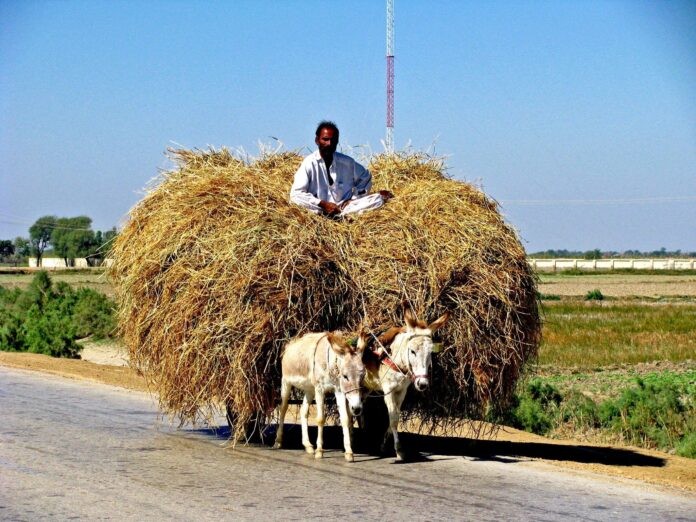KARACHI: In the remote village of Allah Bachayo Phanwar in Sindh, Mithal Chandio was combing through the debris looking for intact bricks so he could begin rebuilding his house, which was flattened by last month’s devastating floods that submerged one-third of the country.
His belongings included damp blankets, a pedestal fan, a few bags and trunks full of clothes, and some crockery. When floods hit his village last month, he could only grab that much.
Located on the outskirts of Dadu district in Sindh, one of the worst affected regions, the village — like nearly all others in the area — was completely inundated by the floods, which forced around 500 residents to take refuge on a nearby road.
The raging water levels have since receded, leaving behind clear signs of massive destruction with nothing left intact.
The village is still surrounded by 4- to 5-foot deep water, giving it an island look. Swarms of mosquitoes and houseflies continuously swirl around.
Boats are the only way to reach the ruined village, bring food, or transport the sick to the hospital.
“Only men from 10 to 12 families have returned so far during the past week to assess the damage and prospects of repairing the houses, which are currently uninhabited,” Mithal Chandio, a local farmer, told Anadolu Agency.
The women and children will join when at least one room of each house is made livable, according to Chandio, who has five children.
“Nothing is left intact here. It seems that we have to start from zero,” he said, pointing towards the razed walls and cracked wooden doors of his small house.
Another resident, Ghulam Omer, said the village was also hit by flooding in 2010, but the scale of the devastation was far less.
“This time, triple the amount of water came and left nothing behind except devastation and helplessness.
“We are facing a dual challenge. First, we have to have money for reconstruction of our houses, and secondly arrange livelihoods as the massive rains and floods have already wiped out our crops,” Omer added.
His cropland is still under water, with no chance of receding in the coming weeks if not months.
Unsure about future
Munir Leghari lost his house in the 2010 floods, which took him the next eight years to rebuild.
But he and his family were only able to live in the new house for four years as the recent floods once again deprived them of a dwelling place.
“I had worked so hard to rebuild my house and pay off the loans. But I have lost it again,” Leghari told Anadolu Agency.
He was loading luggage on a canoe at Chandan Mori, also known as Zero Point, located around 15 kilometres (9.3 miles) from Dadu city, to return to his village after over a month. His family, which is currently staying at a shelter camp in Dadu, will join him “soon.”
“I don’t know if I will be able to rebuild my house again. It had taken me a good eight years, but I don’t know how many years it will take this time, especially when resources have run out,” he said.
At least Rs500,000 are needed to build a small house — money that Leghari and many others don’t have.
He said his first priority is to find some work to earn a living, which has become so challenging due to an economic slowdown.
“If I don’t find work in a day or two, I plan to leave for Karachi or Hyderabad to find something there.
“I am not sure what to do,” he said before heading towards Ibrahim Laghari village near the town of Johi.
Drainage of floodwaters required
A combination of torrential rains – 10 times heavier than usual – and apocalyptic floods have killed nearly 1,700 people across Pakistan since mid-June.
The colossal devastation will cost $40 billion to fix, according to government estimates.
The drenching monsoon, combined with massive floods, has damaged approximately 45 percent of the country’s cropland, posing a serious threat to food security.
Mohammad Musa Babbar, an official at the Al-Khidmat Foundation, one of the country’s largest relief and rescue organizations, said that the immediate drainage of floodwaters is essential for the resumption of economic activity and the reconstruction process.
“Almost 80 percent of the land in Dadu and adjoining districts are still under water, even after a gap of over a month, hampering the rehabilitation and reconstruction process,” said Babbar, whose organization plans to help flood victims rebuild their homes.
There is a shortage of construction materials, particularly bricks, as almost 80 percent of the brick kilns in Sindh are closed due to the inundation of large swathes of land.
Even if bricks are available, Babbar said, their transportation is a big issue due to the inundation of roads.
“The government’s top priority should be the clearance of land and roads, which will generate huge economic activity in terms of agriculture and reconstruction, aside from providing jobs to thousands of flood victims,” he added.





















